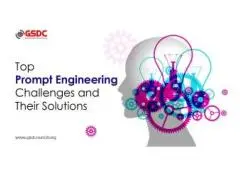Top Prompt Engineering Challenges and Their Solutions?
Description
Introduction:- As generative AI becomes a vital part of industries like content creation, law, healthcare, and automation, prompt engineering has emerged as one of the most critical skills in tech. It’s more than just asking a question—it's about having the know-how to communicate effectively with AI to get accurate, ethical, and meaningful results. But while the power of AI is undeniable, prompt engineering comes with challenges that can trip up even experienced users. Let’s break down these common hurdles—and more importantly, how to solve them. Common Prompt Engineering Challenges Ambiguous Prompts Vague prompts like “Describe advances in technology” often return generic or unfocused answers. Without specificity, AI struggles to understand exactly what you want. Cliché Responses If the AI isn’t guided properly, it may give bland, repetitive answers. Poorly framed promptsoften lack the structure needed to deliver quality content. Handling Complexity AI can falter when given multi-step tasks without clear instructions, leading to incomplete or confused responses. Inconsistent Tone or Style Maintaining a consistent voice—whether professional, casual, or friendly—is a challenge if the AI isn’t told how to behave. Too Much Context Overloading prompts with information can confuse the model, leading to scattered or off-target answers. AI Hallucinations Sometimes, the AI generates false or misleading information, especially if it lacks access to verified facts. Data Privacy Concerns In sensitive industries, ensuring data confidentiality is crucial but often overlooked in prompt design. Need for Iteration Crafting the perfect prompt is usually an iterative process, which can be time-consuming but is essential for accuracy. Proven Solutions That Work Use specific, targeted prompts to guide the model. For example, instead of “Explain climate change,” ask “Explain how climate change has affected polar ice caps in the last decade.” Include example-based prompting to reduce vague answers. Give the AI a format to follow. Try chain-of-thought prompting for complex tasks. Break problems into smaller steps for better logical flow. Maintain tone with persona-driven prompts like “You’re a friendly support agent helping a customer.” Balance input by highlighting key instructions while keeping context concise. Reduce hallucinations using retrieval-augmented generation (RAG)—integrating the model with verified external data sources. Ensure data privacy with strong encryption and by complying with regulations like GDPR or HIPAA. Embrace iterative refinement. Review and adjust prompts until you get the results you need. Your Path to Becoming a Prompt Engineering Pro To level up your skills: Dive into self-learning with online tutorials, blogs, and AI tools. Join tech communities on platforms like LinkedIn and Reddit. Attend workshops and bootcamps for hands-on experience. Enroll in a prompt engineering certification to gain real-world examples and solidify your skills. Final Thoughts Prompt engineering is part art, part science—and every failed attempt is a step toward mastery. The better your prompts, the better your results. Whether you’re solving problems, creating content, or driving innovation, learning to communicate effectively with AI gives you a powerful edge in today’s digital world.






You must log in or register a new account in order to contact the publisher
Useful information
- Avoid scams by acting locally or paying with PayPal
- Never pay with Western Union, Moneygram or other anonymous payment services
- Don't buy or sell outside of your country. Don't accept cashier cheques from outside your country
- This site is never involved in any transaction, and does not handle payments, shipping, guarantee transactions, provide escrow services, or offer "buyer protection" or "seller certification"







